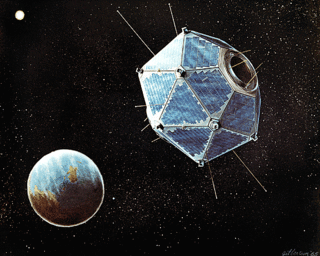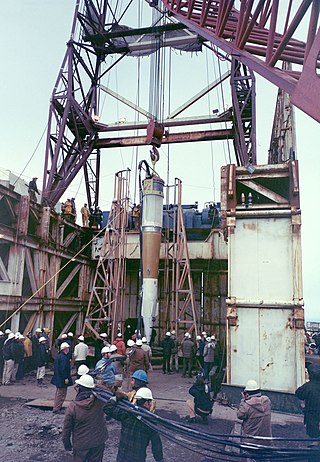Related Research Articles

The Comprehensive Nuclear-Test-Ban Treaty (CTBT) is a multilateral treaty to ban nuclear weapons test explosions and any other nuclear explosions, for both civilian and military purposes, in all environments. It was adopted by the United Nations General Assembly on 10 September 1996, but has not entered into force, as eight specific nations have not ratified the treaty.

Seismology is the scientific study of earthquakes and the generation and propagation of elastic waves through the Earth or other planetary bodies. It also includes studies of earthquake environmental effects such as tsunamis as well as diverse seismic sources such as volcanic, tectonic, glacial, fluvial, oceanic microseism, atmospheric, and artificial processes such as explosions and human activities. A related field that uses geology to infer information regarding past earthquakes is paleoseismology. A recording of Earth motion as a function of time, created by a seismograph is called a seismogram. A seismologist is a scientist works in basic or applied seismology.

A nuclear bunker buster, also known as an earth-penetrating weapon (EPW), is the nuclear equivalent of the conventional bunker buster. The non-nuclear component of the weapon is designed to penetrate soil, rock, or concrete to deliver a nuclear warhead to an underground target. These weapons would be used to destroy hardened, underground military bunkers or other below-ground facilities. An underground explosion releases a larger fraction of its energy into the ground, compared to a surface burst or air burst explosion at or above the surface, and so can destroy an underground target using a lower explosive yield. This in turn could lead to a reduced amount of radioactive fallout. However, it is unlikely that the explosion would be completely contained underground. As a result, significant amounts of rock and soil would be rendered radioactive and lofted as dust or vapor into the atmosphere, generating significant fallout.

Infrasound, sometimes referred to as low frequency sound, describes sound waves with a frequency below the lower limit of human audibility. Hearing becomes gradually less sensitive as frequency decreases, so for humans to perceive infrasound, the sound pressure must be sufficiently high. Although the ear is the primary organ for sensing low sound, at higher intensities it is possible to feel infrasound vibrations in various parts of the body.

Nuclear weapons tests are experiments carried out to determine the performance, yield, and effects of nuclear weapons. Testing nuclear weapons offers practical information about how the weapons function, how detonations are affected by different conditions, and how personnel, structures, and equipment are affected when subjected to nuclear explosions. However, nuclear testing has often been used as an indicator of scientific and military strength. Many tests have been overtly political in their intention; most nuclear weapons states publicly declared their nuclear status through a nuclear test.
A hypocenter or hypocentre, also called ground zero or surface zero, is the point on the Earth's surface directly below a nuclear explosion, meteor air burst, or other mid-air explosion. In seismology, a hypocenter of an earthquake is its point of origin below ground; a synonym is the focus of an earthquake.

Project Vela was a United States Department of Defense project to monitor Soviet Union compliance with the 1963 Partial Test Ban Treaty. The treaty banned the testing of nuclear weapons in the atmosphere, in outer space, and underwater, but permitted underground testing.

Amchitka is a volcanic, tectonically unstable and uninhabited island in the Rat Islands group of the Aleutian Islands in southwest Alaska. It is part of the Alaska Maritime National Wildlife Refuge. The island, with a land area of roughly 116 square miles (300 km2), is about 42 miles (68 km) long and 1 to 4 miles wide. The area has a maritime climate, with many storms, and mostly overcast skies.
Peaceful nuclear explosions (PNEs) are nuclear explosions conducted for non-military purposes. Proposed uses include excavation for the building of canals and harbours, electrical generation, the use of nuclear explosions to drive spacecraft, and as a form of wide-area fracking. PNEs were an area of some research from the late 1950s into the 1980s, primarily in the United States and Soviet Union.
The Comprehensive Nuclear-Test-Ban Treaty Organization (CTBTO) is an international organization that will be established upon the entry into force of the Comprehensive Nuclear-Test-Ban Treaty, a Convention that outlaws nuclear test explosions. Its seat will be in Vienna, Austria. The organization will be tasked with verifying the ban on nuclear tests and will operate therefore a worldwide monitoring system and may conduct on-site inspections. The Preparatory Commission for the CTBTO, and its Provisional Technical Secretariat, were established in 1997 and are headquartered in Vienna, Austria.
Nuclear Explosions for the National Economy was a Soviet program to investigate peaceful nuclear explosions (PNEs). It was analogous to the United States program Operation Plowshare.

The Air Force Technical Applications Center (AFTAC), based at Florida's Patrick Space Force Base, is an Air Force surveillance organization assigned to the Sixteenth Air Force. Its mission is to monitor nuclear treaties of all applicable signatory countries. This is accomplished using seismic, hydroacoustic and satellite-detection systems alongside ground based and airborne materials collection systems.

An underwater explosion is a chemical or nuclear explosion that occurs under the surface of a body of water. While useful in anti-ship and submarine warfare, underwater bombs are not as effective against coastal facilities.

Underground nuclear testing is the test detonation of nuclear weapons that is performed underground. When the device being tested is buried at sufficient depth, the nuclear explosion may be contained, with no release of radioactive materials to the atmosphere.
National technical means of verification (NTM) are monitoring techniques, such as satellite photography, used to verify adherence to international treaties. The phrase first appeared, but was not detailed, in the Strategic Arms Limitation Treaty (SALT) between the US and USSR. At first, the phrase reflected a concern that the "Soviet Union could be particularly disturbed by public recognition of this capability [satellite photography]...which it has veiled.". In modern usage, the term covers a variety of monitoring technologies, including others used at the time of SALT I.
A sympathetic detonation, also called flash over or secondary/secondaries (explosion), is a detonation, usually unintended, of an explosive charge by a nearby explosion.

The Preparatory Commission for the Comprehensive Nuclear-Test-Ban Treaty Organization, or CTBTO Preparatory Commission, is an international organization based in Vienna, Austria, that is tasked with building up the verification regime of the Comprehensive Nuclear-Test-Ban Treaty Organization (CTBTO). The organization was established by the States Signatories to the Comprehensive Nuclear-Test-Ban Treaty (CTBT) in 1996.
A nuclear detonation detection system (NDDS) is a device or a series of devices that are able to indicate, and pinpoint a nuclear explosion has occurred as well as the direction of the explosion. The main purpose of these devices or systems was to verify compliance of countries that signed nuclear treaties such as the Partial Test Ban treaty of 1963 (PTBT) and the Treaty of Tlatelolco.
The World-Wide Standardized Seismograph Network (WWSSN) – originally the World-Wide Network of Seismograph Stations (WWNSS) – was a global network of about 120 seismograph stations built in the 1960s that generated an unprecedented collection of high quality seismic data. This data enabled seismology to become a quantitative science, elucidated the focal mechanisms of earthquakes and the structure of the Earth's crust, and contributed to the development of plate tectonic theory. The WWSSN is credited with spurring a renaissance in seismological research.

Ground motion is the movement of the Earth’s surface from earthquakes or explosions. Ground motion is produced by seismic waves that are generated by sudden slip on a fault or sudden pressure at the explosive source and travel through the Earth and along its surface. This can be due to natural events, such as earthquakes and volcanic eruptions, or human activities, such as the detonation of nuclear weapons. There are two main types of seismic waves: body waves and surface waves. Body waves travel through the interior of the Earth, while surface waves travel along the Earth's surface. Ground motion is typically caused by surface waves, which are the most destructive type of seismic waves.
References
- 1 2 J. David Rogers and Keith D. Koper. "Some Practical Applications of Forensic Seismology" (PDF). Retrieved 2011-09-09.
- ↑ John J. Zucca (September 1998). "Forensic Seismology Supports CTBT". Lawrence Livermore National Laboratory. Archived from the original on 2013-11-03. Retrieved 2011-09-09.
- ↑ Koper, K. D., T. C. Wallace, and R. C. Aster (2003), Seismic recordings of the Carlsbad, New Mexico, pipeline explosion of 19 August 2000, Bulletin of the Seismological Society of America, 93(4), 1427-1432
- ↑ Martin, S., R. Drucker, R. Aster, F. Davey, E. Okal, T. Scambos, and D. MacAyeal (2010), Kinematic and seismic analysis of giant tabular iceberg breakup at Cape Adare, Antarctica, Journal of Geophysical Research-Solid Earth, 115, doi:10.1029/2009JB006700
- ↑ Richard A. Lovett (5 March 2009). "Forensic seismology". COSMOS magazine. Archived from the original on 9 March 2011. Retrieved 9 September 2011.
- ↑ Christina Reed (February 2001). "Sinking the Kursk". GeoTimes. Retrieved 2011-09-09.
- 1 2 3 4 5 6 7 "Forensic Seismology Supports CTBT". str.llnl.gov. Archived from the original on 2013-11-03. Retrieved 2017-04-23.
- 1 2 3 APPENDIX E Dealing with Evasive Underground Nuclear Testing | The Comprehensive Nuclear Test Ban Treaty: Technical Issues for the United States | The National Academies Press. 2012. doi:10.17226/12849. hdl:2027/mdp.39015041921126. ISBN 978-0-309-14998-3.
- ↑ Douglas, Alan (2017). Forensic Seismology and Nuclear Test Bans. Cambridge University Press. ISBN 9781107033948.
- ↑ Dahlman, Ola and Hans Israelson. Monitoring Underground Nuclear Explosions. New York: Elsevier, 1977,440pp.